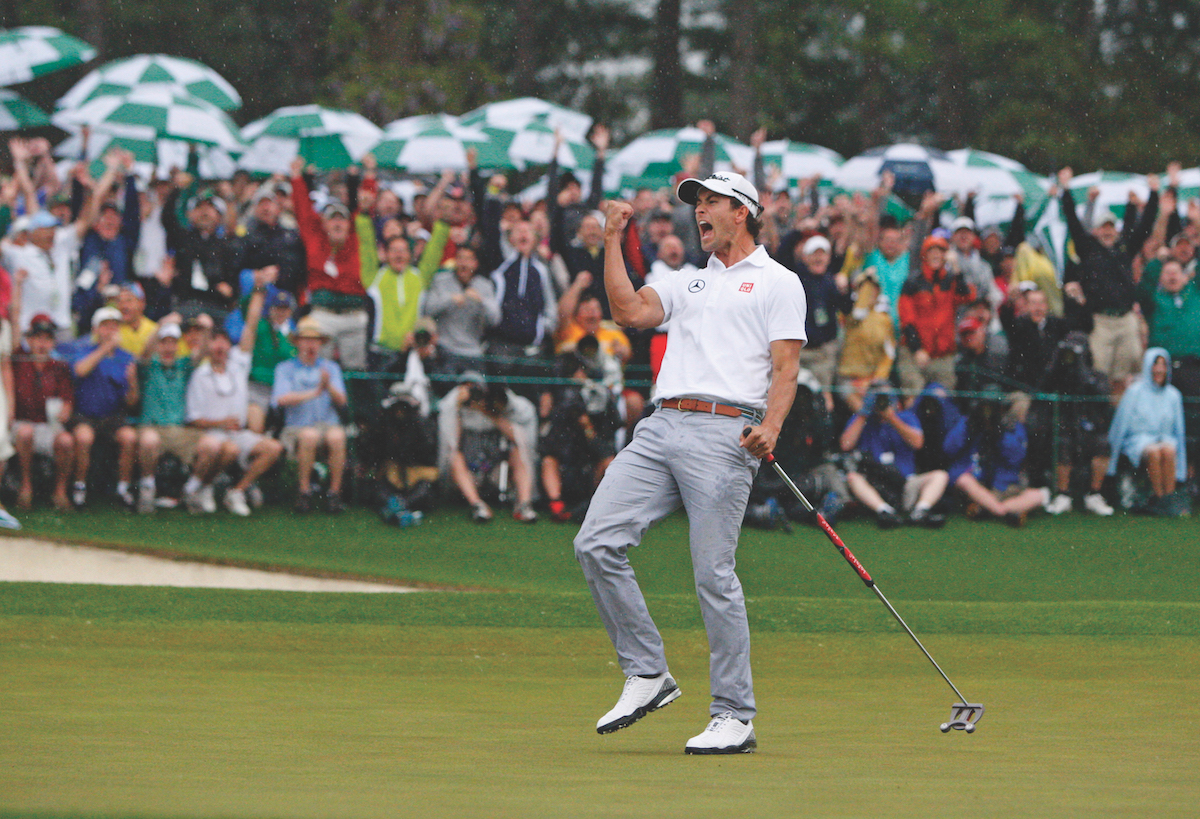Nice guys don’t normally win. But then there’s Adam Scott. In a career spanning more than two decades, Scott has won a remarkable 31 professional tournaments. He has worn the green jacket at the Augusta National, having taken the top spot at the 2013 US Masters (he remains the only Australian to have done so) and, one year later, he was the world’s No. 1-ranked golfer for nearly four months.
Arranging to speak with Scott, 42, can be a challenge. One minute he’s in Switzerland, where he lives. The next he’s in Florida for the Arnold Palmer Invitational. His schedule of tournaments, practice rounds and international travel is a whirl of minders, carefully orchestrated commitments and tiny windows of opportunity. Add to this the pressure that comes from teeing up and doing battle with the world’s best, plus the fact that golf itself is facing a rare and very public moment of upheaval and controversy, with the breakaway LIV league now running parallel to the traditional PGA tour. Such is the life of an elite golfer.
Yet when we speak via video call, Scott is the calm amid the storm that swirls around him. He has no time for the hype. Celebrity, one suspects, is merely a consequence of what he does, not an end in itself. It’s easy to imagine that he treats media interviews with the same quiet equanimity that he does an early morning surf off the Sunshine Coast where he grew up or even morning preparations for a big tournament.
“I certainly am fairly quiet and focus on just processing my thoughts,” he says. “Sometimes having something else to do on the morning of a big round is a nice thing, because you need to distract yourself from your own thoughts. Sometimes the worst thing you can do is go over a million scenarios that aren’t even really happening. I know myself pretty well and generally manage that fairly well.”
He shrugs. “But sometimes it works out and sometimes it doesn’t.” A case in point is the Australian Open late last year, in which Scott finished second to the Polish pro Adrian Meronk. “That was an important final round for me and I played OK,” says Scott, “but the other guy played better than me that day and it’s a hard loss. I didn’t feel like I gave the tournament away. He just played a great round of golf.”

I imagine that Scott would rather spend this precious break in his schedule either playing golf or being with his family, but he gives no such sign and remains warm and personable throughout our conversation. In 2019 and again in 2022, Scott appeared in Golf Digest’s Top 30 Nice Guys on the PGA Tour. It’s a theme that runs like a thread through our interview: that where you come from and your values — both as a person and as a golfer — matter.
When I ask Scott what advice he would give his 12-year-old self, I get the sense that he’s someone who wouldn’t change a thing. “My parents did a good job of telling me about golf and about life, and they didn’t really sugar-coat it for me,” he says. “They were very encouraging at the same time, so I wouldn’t think I would be telling myself anything different than that.”
With his father, Phil, a golf pro, Adam says he was lucky to be introduced to the sport at a young age. “I think the rules and the etiquette of the game prepared me for life a little bit,” he explains. “You get some bad bounces occasionally and there’s not much you can do about it. You have to prepare yourself for the next shot, whether that’s in life or golf, and do the best you can.”
“That’s why I really like trying to encourage juniors to just play the game and at least learn the game,” he continues. “They don’t have to be world-beaters as players, but growing up at a golf club, in that environment, was very good for me.”
There is, of course, a steely resolve behind Scott’s affable demeanour. It is a single-mindedness that traces a line from those bad bounces to having the courage to get up and play on, and from the disappointment of losing the 2012 Open Championship at Royal Lytham & St Annes Golf Club in Lancashire, England, to winning the nail-biting 2013 Masters at Augusta just months later.
“That attribute of not throwing in the towel is something I try to pride myself on,” says Scott. “I’m not always in the final group and on television. But when you’re having a bad week and you’re somewhat making up the numbers, I’m still giving my best out there, and my self-pride prevents me from throwing the towel in and posting horrendous numbers. Sometimes those moments when you’re not at the top of the leaderboard and you stick with it can help you when you are at the top of the leaderboard.”
It helps that Scott has what the respected golf teacher Claude Harmon III once described as “the best golf swing in the world on any tour”. In case you missed his point, Harmon told Golf Digest in an online tutorial: “If I could design a golf swing, this is what it would look like.” Scott makes the game look easy: smooth as silk, all constituent parts working in perfect harmony.
He also happens to be one of the best-dressed players on the course (in 2018, Esquire magazine identified Scott as one of those “leading the charge” in golf’s increasingly fashionable aesthetic). He may shy away from such characterisations but when the subject turns to watches, the Rolex ambassador of 22 years has plenty to say. “I’m a real watch guy,” he admits. “The first ever Rolex I chose to buy when I was with them was a pink and gold [Everose] Rolex Day-Date. For a 20- or 21-year-old it was maybe an odd choice looking back at it, but that’s still such a beautiful watch today. It’s a timeless design, and what looked good 20 years ago to a 20-year-old still looks good to a 40-year-old today.”
But there’s one watch he treasures above all others. “In 2013, Rolex presented me with a Rolex Sky-Dweller for winning the Masters, and it’s engraved on the back with ‘Masters Champion’,” he says. “That’s obviously a very special timepiece to me.”

One of the lesser-known benefits of sponsorship, he adds, is that he’s been able to form connections with other ambassadors of the brand. Through Rolex — which has been associated with the sport since 1967 — Scott has come to know legends of the game, including Arnold Palmer, Jack Nicklaus and Gary Player, as well as the tennis player Stefan Edberg. He remembers with fondness and admiration another Rolex-sponsored golfer, and the influence he has had on his own career. “José María Olazábal is a great two-time Masters champion and I played a lot with him early in my career in Europe,” Scott says.
“I played with him when he struggled mightily on the course, but you know that every shot he played, he gave it his all. I really admired that about him and I don’t think I can do it as well as José, but I’ve tried to.”
When we speak, the 2023 Masters is barely a month away. Now that Scott has children, he chooses his touring schedule carefully. His calendar is focused on trying to win the majors, and this one is the most significant. “Even though I’ve been there a lot and I’ve won and I have an incredible experience every year — including the Champions Dinner on the Tuesday night before the tournament — it’s one of the highlights of my year, every year,” he says. “When a friend or somebody I meet at the Masters is there for the first time, you’re quickly reminded how special the place is. Last year a friend of mine was there for the first time and I think seven days in a row there were tears in his eyes just to be there.”
For all the traditions and the importance Scott attaches to them, he knows that golf today is a very different game to the one he played as a child. He enjoys the help that ever-evolving golf science, such as swing analysis, can offer. “The technology is so helpful to reassure you that, yes, this is absolutely what’s happening,” he says. “I think for some younger players who grew up learning with the technology, it can actually help you and guide you into a better golf swing. I learned my swing before there was all this fancy stuff, so now it’s really good if I’m not feeling it that my coach can easily show me off his phone.
“The 20-year-olds are now so prepared for the tour,” he continues. “Their learning curve is much shorter with the data and the analysis than when I turned pro.”

As golf’s basic equipment evolves at a similarly rapid pace, Scott never stops trying to gain what could be a critical edge. “Every week, every one of us out here is looking for that,” he says. “A new golf spike comes out and you wonder, ‘Is it just a little bit better?’ ”
But, for all its dazzling possibilities, the new technology can’t remove the human element from the game. “You can do a lot of things right and end up not having a good score,” says Scott. “You can try your best and tick every box and it doesn’t go your way. You get one bad break and a triple bogey [a score of three strokes over par for a hole] can end your week
although everything else was good. It’s a very tough game and it’s not really fair at times, so to be mentally strong is incredibly important in golf, and confidence is part of that mental game.”
Scott worries that while young golfers have all the technological advantages, they’re not being adequately taught to cope with pressure. For this, Scott knows that a life outside of golf can be a player’s saviour. “Maybe I could be criticised earlier in my career as being too open to surfing or something else and it having an effect on my performance,” he says, “but I think I’ve maintained a really good balance and I think it’s important to having a long career, because there is that chance of burnout. Now I see kids, 13- and 14-year-olds, who are training like tour pros and I can’t imagine how they’re going to love golf into their 20s.”
The issue of golf’s future comes up frequently in our conversation. On a personal level, Scott knows he is closer to the end of his career than to the beginning. While he has no plans to retire yet, he is increasingly passionate about making golf more accessible and appealing to young people. (His interest in future generations extends beyond the course; since 2005, the Adam Scott Foundation has helped underprivileged and disadvantaged Australians further their education.)
To make golf more attractive to children, he’d like to see an increase in par-3 courses, which are quicker and cheaper to play. The sport must move with the times, he says, and distance itself from “the stigma of it being played at a country club and being elitist, expensive and boring”.
That would require a fundamental shift towards a game that is, in Scott’s words: “a bit more inclusive of what everyone wants today, with childcare facilities at clubs, gyms, juice bars and coffee shops. It can happen. We just have to be open to changing the way it’s been done for probably 100 years.”
Scott is keenly aware of both the benefits and struggles of getting older while performing at the highest level. “I think advancements in technology and the game, sports science, recovery and training in golf have become very good, and that’s keeping me in a really good spot physically,” he says. “But golf gets harder. One of the big things I have to my advantage at this point is I’ve been through highs and lows and I know what I can do, what helps me make it easier for myself, so I try to do a lot of those things all the time. But it is a very mental game and the body will slow down eventually. That will be an interesting time. I don’t know how I’m going to handle it.”
Yet there is still within Scott the young kid who fell in love with the game back in Australia. “I could never see the day when I stopped playing golf,” he says. “I just love it too much.” And like that kid, he still dreams of winning majors. His many fans hope he can, too — not least because it will be proof, once again, that nice guys can win after all.




 Adam Scott, “a real watch guy”, shows off a Rolex Oyster Perpetual Day-Date 40. Courtesy of Rolex/Thomas Laisné.
Adam Scott, “a real watch guy”, shows off a Rolex Oyster Perpetual Day-Date 40. Courtesy of Rolex/Thomas Laisné.